Report: Case-Control Study Appraisal - Vitamins & Orofacial Clefts
VerifiedAdded on 2023/06/13
|10
|3792
|422
Report
AI Summary
This report provides a critical appraisal of a case-control study examining the relationship between maternal multivitamin use containing folic acid and the risk of orofacial clefts in children. The report describes the characteristics of a case-control study, justifying the author's choice of this design over a cohort study. It evaluates the association between maternal vitamin use and orofacial clefts, discussing the strengths and limitations of the analysis. Furthermore, the report addresses the impact of study design features, including case and control selection, exposure assessment, and methods for controlling confounding variables. Finally, it interprets the study's results, considering the evidence to assess the effect of maternal multivitamin use on the risk of orofacial clefts, concluding with the importance of folic acid during pregnancy.
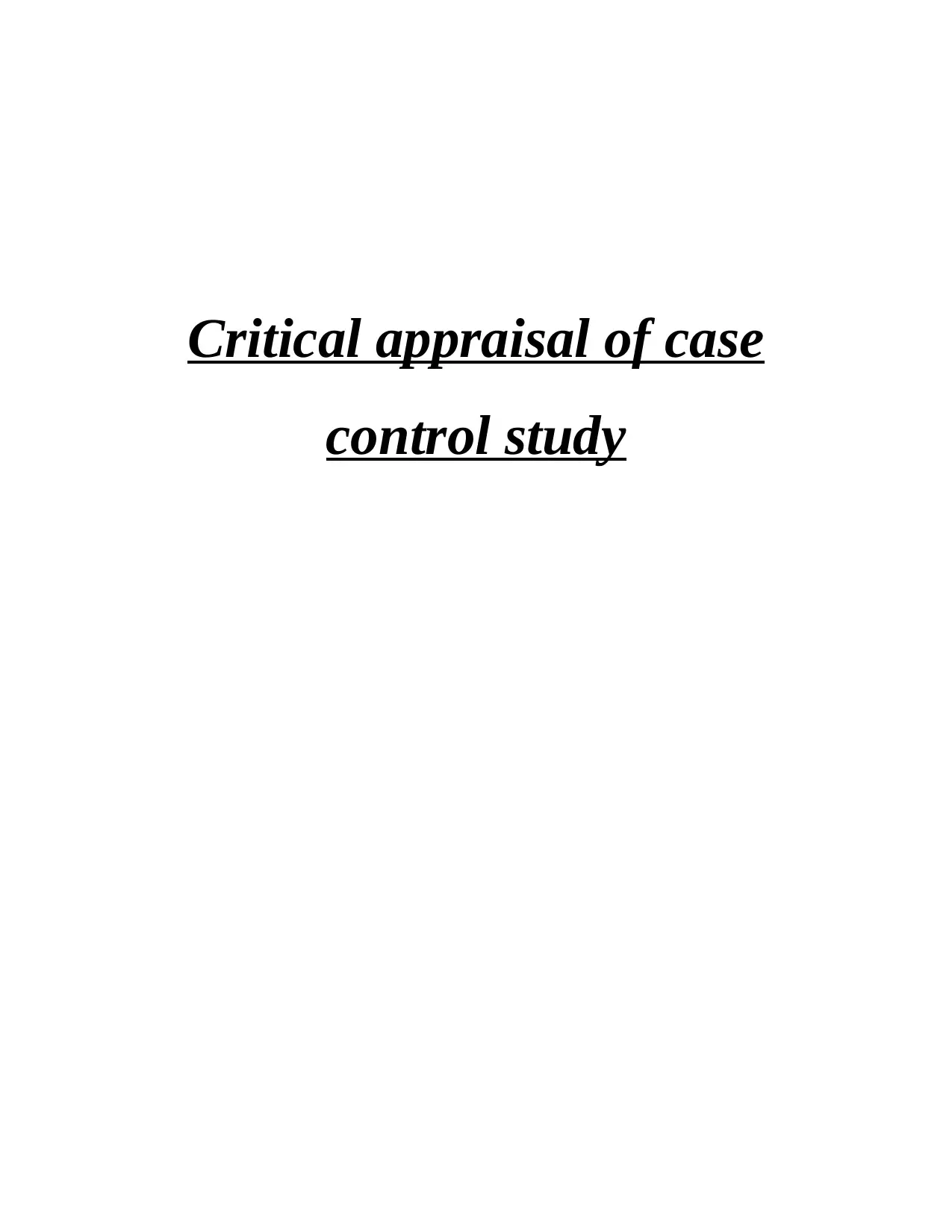
Critical appraisal of case
control study
control study
Paraphrase This Document
Need a fresh take? Get an instant paraphrase of this document with our AI Paraphraser

Table of Contents
INTRODUCTION...........................................................................................................................3
MAIN BODY...................................................................................................................................3
CONCLUSION................................................................................................................................7
REFERENCES................................................................................................................................8
INTRODUCTION...........................................................................................................................3
MAIN BODY...................................................................................................................................3
CONCLUSION................................................................................................................................7
REFERENCES................................................................................................................................8
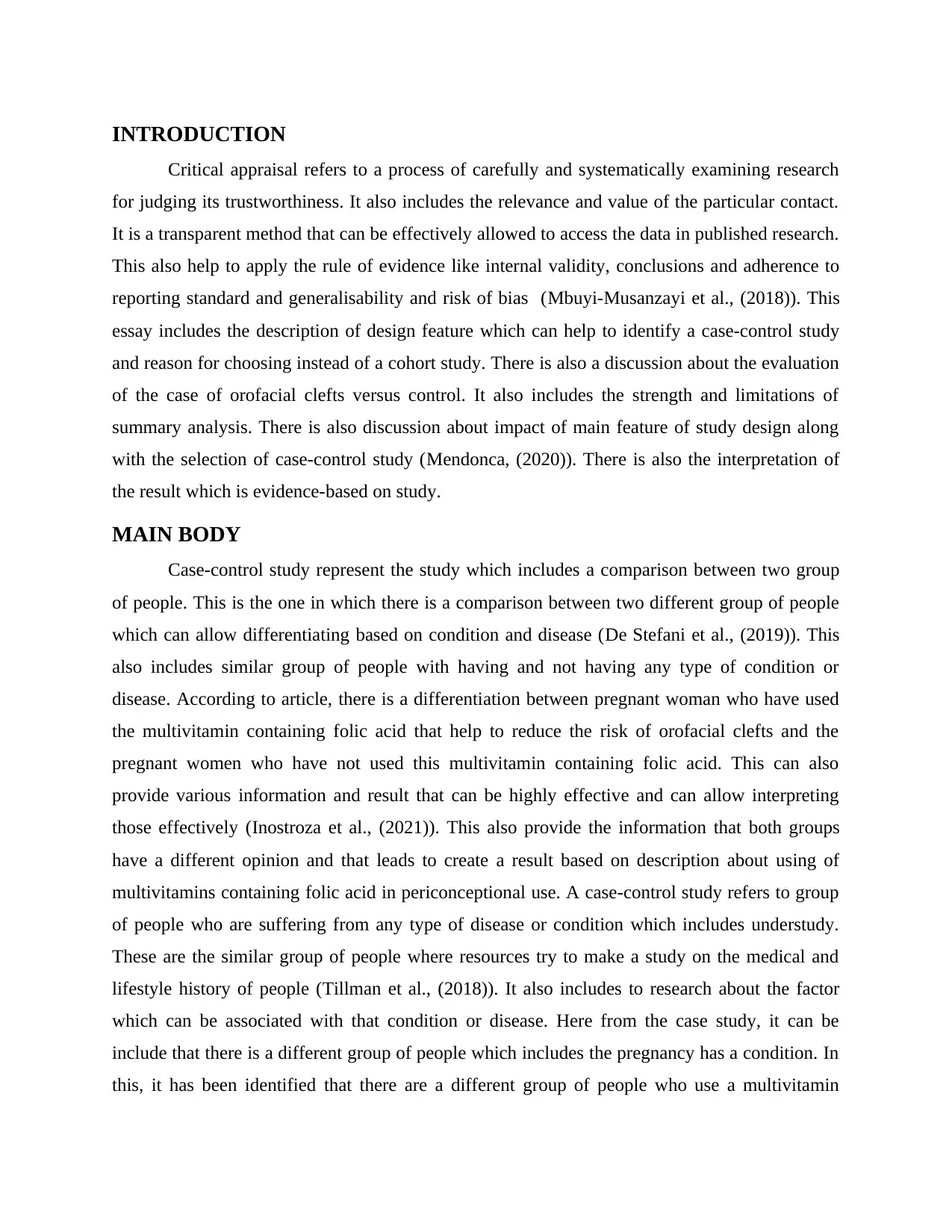
INTRODUCTION
Critical appraisal refers to a process of carefully and systematically examining research
for judging its trustworthiness. It also includes the relevance and value of the particular contact.
It is a transparent method that can be effectively allowed to access the data in published research.
This also help to apply the rule of evidence like internal validity, conclusions and adherence to
reporting standard and generalisability and risk of bias (Mbuyi-Musanzayi et al., (2018)). This
essay includes the description of design feature which can help to identify a case-control study
and reason for choosing instead of a cohort study. There is also a discussion about the evaluation
of the case of orofacial clefts versus control. It also includes the strength and limitations of
summary analysis. There is also discussion about impact of main feature of study design along
with the selection of case-control study (Mendonca, (2020)). There is also the interpretation of
the result which is evidence-based on study.
MAIN BODY
Case-control study represent the study which includes a comparison between two group
of people. This is the one in which there is a comparison between two different group of people
which can allow differentiating based on condition and disease (De Stefani et al., (2019)). This
also includes similar group of people with having and not having any type of condition or
disease. According to article, there is a differentiation between pregnant woman who have used
the multivitamin containing folic acid that help to reduce the risk of orofacial clefts and the
pregnant women who have not used this multivitamin containing folic acid. This can also
provide various information and result that can be highly effective and can allow interpreting
those effectively (Inostroza et al., (2021)). This also provide the information that both groups
have a different opinion and that leads to create a result based on description about using of
multivitamins containing folic acid in periconceptional use. A case-control study refers to group
of people who are suffering from any type of disease or condition which includes understudy.
These are the similar group of people where resources try to make a study on the medical and
lifestyle history of people (Tillman et al., (2018)). It also includes to research about the factor
which can be associated with that condition or disease. Here from the case study, it can be
include that there is a different group of people which includes the pregnancy has a condition. In
this, it has been identified that there are a different group of people who use a multivitamin
Critical appraisal refers to a process of carefully and systematically examining research
for judging its trustworthiness. It also includes the relevance and value of the particular contact.
It is a transparent method that can be effectively allowed to access the data in published research.
This also help to apply the rule of evidence like internal validity, conclusions and adherence to
reporting standard and generalisability and risk of bias (Mbuyi-Musanzayi et al., (2018)). This
essay includes the description of design feature which can help to identify a case-control study
and reason for choosing instead of a cohort study. There is also a discussion about the evaluation
of the case of orofacial clefts versus control. It also includes the strength and limitations of
summary analysis. There is also discussion about impact of main feature of study design along
with the selection of case-control study (Mendonca, (2020)). There is also the interpretation of
the result which is evidence-based on study.
MAIN BODY
Case-control study represent the study which includes a comparison between two group
of people. This is the one in which there is a comparison between two different group of people
which can allow differentiating based on condition and disease (De Stefani et al., (2019)). This
also includes similar group of people with having and not having any type of condition or
disease. According to article, there is a differentiation between pregnant woman who have used
the multivitamin containing folic acid that help to reduce the risk of orofacial clefts and the
pregnant women who have not used this multivitamin containing folic acid. This can also
provide various information and result that can be highly effective and can allow interpreting
those effectively (Inostroza et al., (2021)). This also provide the information that both groups
have a different opinion and that leads to create a result based on description about using of
multivitamins containing folic acid in periconceptional use. A case-control study refers to group
of people who are suffering from any type of disease or condition which includes understudy.
These are the similar group of people where resources try to make a study on the medical and
lifestyle history of people (Tillman et al., (2018)). It also includes to research about the factor
which can be associated with that condition or disease. Here from the case study, it can be
include that there is a different group of people which includes the pregnancy has a condition. In
this, it has been identified that there are a different group of people who use a multivitamin
⊘ This is a preview!⊘
Do you want full access?
Subscribe today to unlock all pages.

Trusted by 1+ million students worldwide
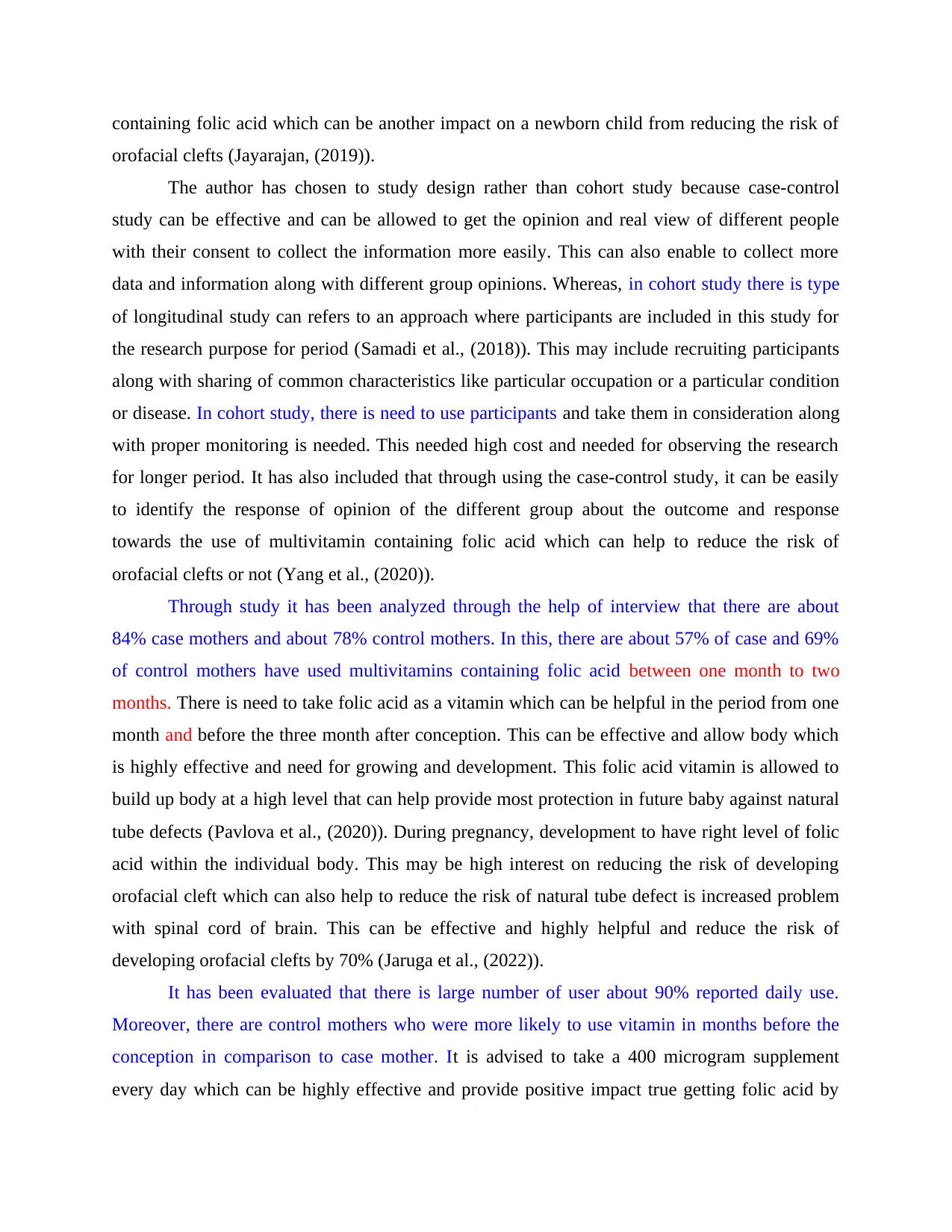
containing folic acid which can be another impact on a newborn child from reducing the risk of
orofacial clefts (Jayarajan, (2019)).
The author has chosen to study design rather than cohort study because case-control
study can be effective and can be allowed to get the opinion and real view of different people
with their consent to collect the information more easily. This can also enable to collect more
data and information along with different group opinions. Whereas, in cohort study there is type
of longitudinal study can refers to an approach where participants are included in this study for
the research purpose for period (Samadi et al., (2018)). This may include recruiting participants
along with sharing of common characteristics like particular occupation or a particular condition
or disease. In cohort study, there is need to use participants and take them in consideration along
with proper monitoring is needed. This needed high cost and needed for observing the research
for longer period. It has also included that through using the case-control study, it can be easily
to identify the response of opinion of the different group about the outcome and response
towards the use of multivitamin containing folic acid which can help to reduce the risk of
orofacial clefts or not (Yang et al., (2020)).
Through study it has been analyzed through the help of interview that there are about
84% case mothers and about 78% control mothers. In this, there are about 57% of case and 69%
of control mothers have used multivitamins containing folic acid between one month to two
months. There is need to take folic acid as a vitamin which can be helpful in the period from one
month and before the three month after conception. This can be effective and allow body which
is highly effective and need for growing and development. This folic acid vitamin is allowed to
build up body at a high level that can help provide most protection in future baby against natural
tube defects (Pavlova et al., (2020)). During pregnancy, development to have right level of folic
acid within the individual body. This may be high interest on reducing the risk of developing
orofacial cleft which can also help to reduce the risk of natural tube defect is increased problem
with spinal cord of brain. This can be effective and highly helpful and reduce the risk of
developing orofacial clefts by 70% (Jaruga et al., (2022)).
It has been evaluated that there is large number of user about 90% reported daily use.
Moreover, there are control mothers who were more likely to use vitamin in months before the
conception in comparison to case mother. It is advised to take a 400 microgram supplement
every day which can be highly effective and provide positive impact true getting folic acid by
orofacial clefts (Jayarajan, (2019)).
The author has chosen to study design rather than cohort study because case-control
study can be effective and can be allowed to get the opinion and real view of different people
with their consent to collect the information more easily. This can also enable to collect more
data and information along with different group opinions. Whereas, in cohort study there is type
of longitudinal study can refers to an approach where participants are included in this study for
the research purpose for period (Samadi et al., (2018)). This may include recruiting participants
along with sharing of common characteristics like particular occupation or a particular condition
or disease. In cohort study, there is need to use participants and take them in consideration along
with proper monitoring is needed. This needed high cost and needed for observing the research
for longer period. It has also included that through using the case-control study, it can be easily
to identify the response of opinion of the different group about the outcome and response
towards the use of multivitamin containing folic acid which can help to reduce the risk of
orofacial clefts or not (Yang et al., (2020)).
Through study it has been analyzed through the help of interview that there are about
84% case mothers and about 78% control mothers. In this, there are about 57% of case and 69%
of control mothers have used multivitamins containing folic acid between one month to two
months. There is need to take folic acid as a vitamin which can be helpful in the period from one
month and before the three month after conception. This can be effective and allow body which
is highly effective and need for growing and development. This folic acid vitamin is allowed to
build up body at a high level that can help provide most protection in future baby against natural
tube defects (Pavlova et al., (2020)). During pregnancy, development to have right level of folic
acid within the individual body. This may be high interest on reducing the risk of developing
orofacial cleft which can also help to reduce the risk of natural tube defect is increased problem
with spinal cord of brain. This can be effective and highly helpful and reduce the risk of
developing orofacial clefts by 70% (Jaruga et al., (2022)).
It has been evaluated that there is large number of user about 90% reported daily use.
Moreover, there are control mothers who were more likely to use vitamin in months before the
conception in comparison to case mother. It is advised to take a 400 microgram supplement
every day which can be highly effective and provide positive impact true getting folic acid by
Paraphrase This Document
Need a fresh take? Get an instant paraphrase of this document with our AI Paraphraser
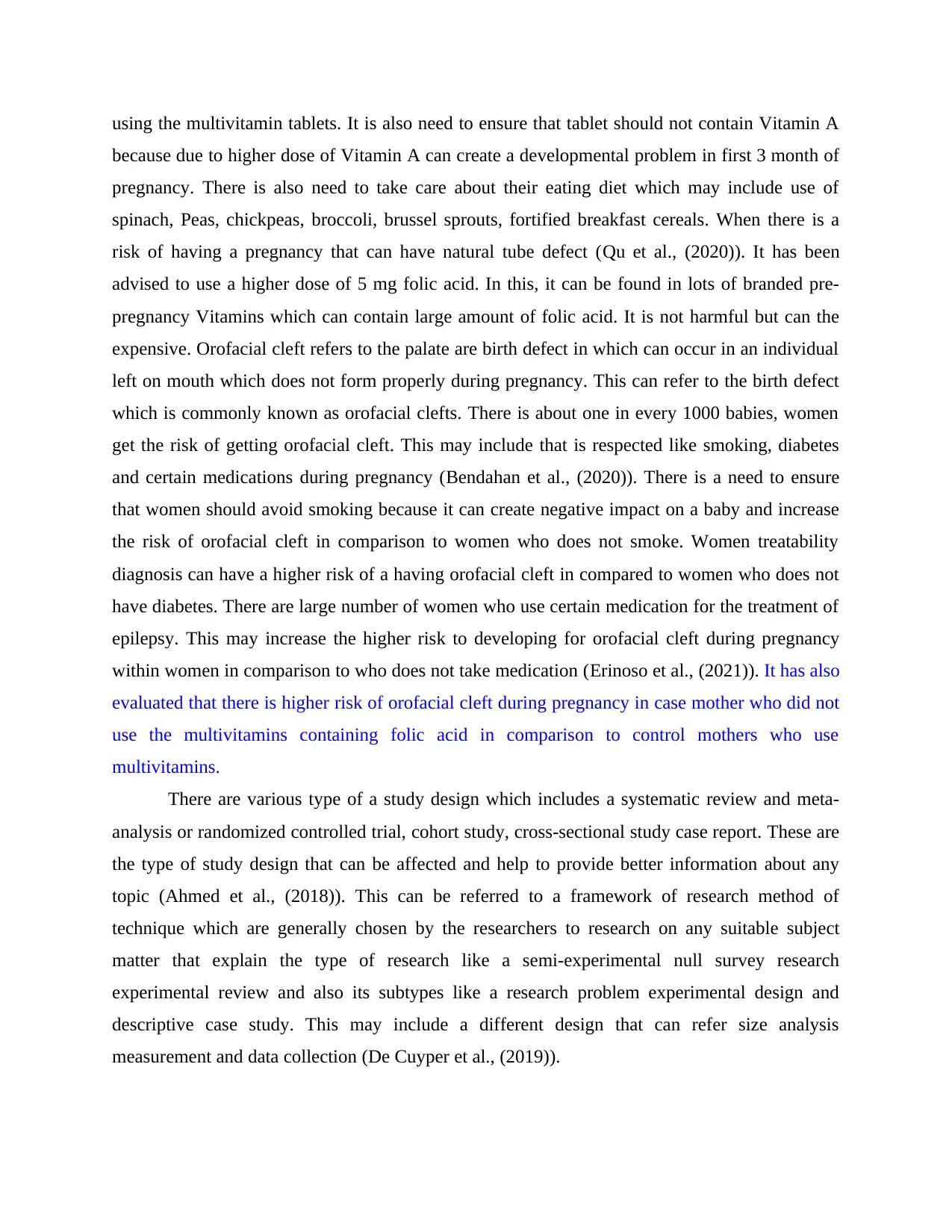
using the multivitamin tablets. It is also need to ensure that tablet should not contain Vitamin A
because due to higher dose of Vitamin A can create a developmental problem in first 3 month of
pregnancy. There is also need to take care about their eating diet which may include use of
spinach, Peas, chickpeas, broccoli, brussel sprouts, fortified breakfast cereals. When there is a
risk of having a pregnancy that can have natural tube defect (Qu et al., (2020)). It has been
advised to use a higher dose of 5 mg folic acid. In this, it can be found in lots of branded pre-
pregnancy Vitamins which can contain large amount of folic acid. It is not harmful but can the
expensive. Orofacial cleft refers to the palate are birth defect in which can occur in an individual
left on mouth which does not form properly during pregnancy. This can refer to the birth defect
which is commonly known as orofacial clefts. There is about one in every 1000 babies, women
get the risk of getting orofacial cleft. This may include that is respected like smoking, diabetes
and certain medications during pregnancy (Bendahan et al., (2020)). There is a need to ensure
that women should avoid smoking because it can create negative impact on a baby and increase
the risk of orofacial cleft in comparison to women who does not smoke. Women treatability
diagnosis can have a higher risk of a having orofacial cleft in compared to women who does not
have diabetes. There are large number of women who use certain medication for the treatment of
epilepsy. This may increase the higher risk to developing for orofacial cleft during pregnancy
within women in comparison to who does not take medication (Erinoso et al., (2021)). It has also
evaluated that there is higher risk of orofacial cleft during pregnancy in case mother who did not
use the multivitamins containing folic acid in comparison to control mothers who use
multivitamins.
There are various type of a study design which includes a systematic review and meta-
analysis or randomized controlled trial, cohort study, cross-sectional study case report. These are
the type of study design that can be affected and help to provide better information about any
topic (Ahmed et al., (2018)). This can be referred to a framework of research method of
technique which are generally chosen by the researchers to research on any suitable subject
matter that explain the type of research like a semi-experimental null survey research
experimental review and also its subtypes like a research problem experimental design and
descriptive case study. This may include a different design that can refer size analysis
measurement and data collection (De Cuyper et al., (2019)).
because due to higher dose of Vitamin A can create a developmental problem in first 3 month of
pregnancy. There is also need to take care about their eating diet which may include use of
spinach, Peas, chickpeas, broccoli, brussel sprouts, fortified breakfast cereals. When there is a
risk of having a pregnancy that can have natural tube defect (Qu et al., (2020)). It has been
advised to use a higher dose of 5 mg folic acid. In this, it can be found in lots of branded pre-
pregnancy Vitamins which can contain large amount of folic acid. It is not harmful but can the
expensive. Orofacial cleft refers to the palate are birth defect in which can occur in an individual
left on mouth which does not form properly during pregnancy. This can refer to the birth defect
which is commonly known as orofacial clefts. There is about one in every 1000 babies, women
get the risk of getting orofacial cleft. This may include that is respected like smoking, diabetes
and certain medications during pregnancy (Bendahan et al., (2020)). There is a need to ensure
that women should avoid smoking because it can create negative impact on a baby and increase
the risk of orofacial cleft in comparison to women who does not smoke. Women treatability
diagnosis can have a higher risk of a having orofacial cleft in compared to women who does not
have diabetes. There are large number of women who use certain medication for the treatment of
epilepsy. This may increase the higher risk to developing for orofacial cleft during pregnancy
within women in comparison to who does not take medication (Erinoso et al., (2021)). It has also
evaluated that there is higher risk of orofacial cleft during pregnancy in case mother who did not
use the multivitamins containing folic acid in comparison to control mothers who use
multivitamins.
There are various type of a study design which includes a systematic review and meta-
analysis or randomized controlled trial, cohort study, cross-sectional study case report. These are
the type of study design that can be affected and help to provide better information about any
topic (Ahmed et al., (2018)). This can be referred to a framework of research method of
technique which are generally chosen by the researchers to research on any suitable subject
matter that explain the type of research like a semi-experimental null survey research
experimental review and also its subtypes like a research problem experimental design and
descriptive case study. This may include a different design that can refer size analysis
measurement and data collection (De Cuyper et al., (2019)).
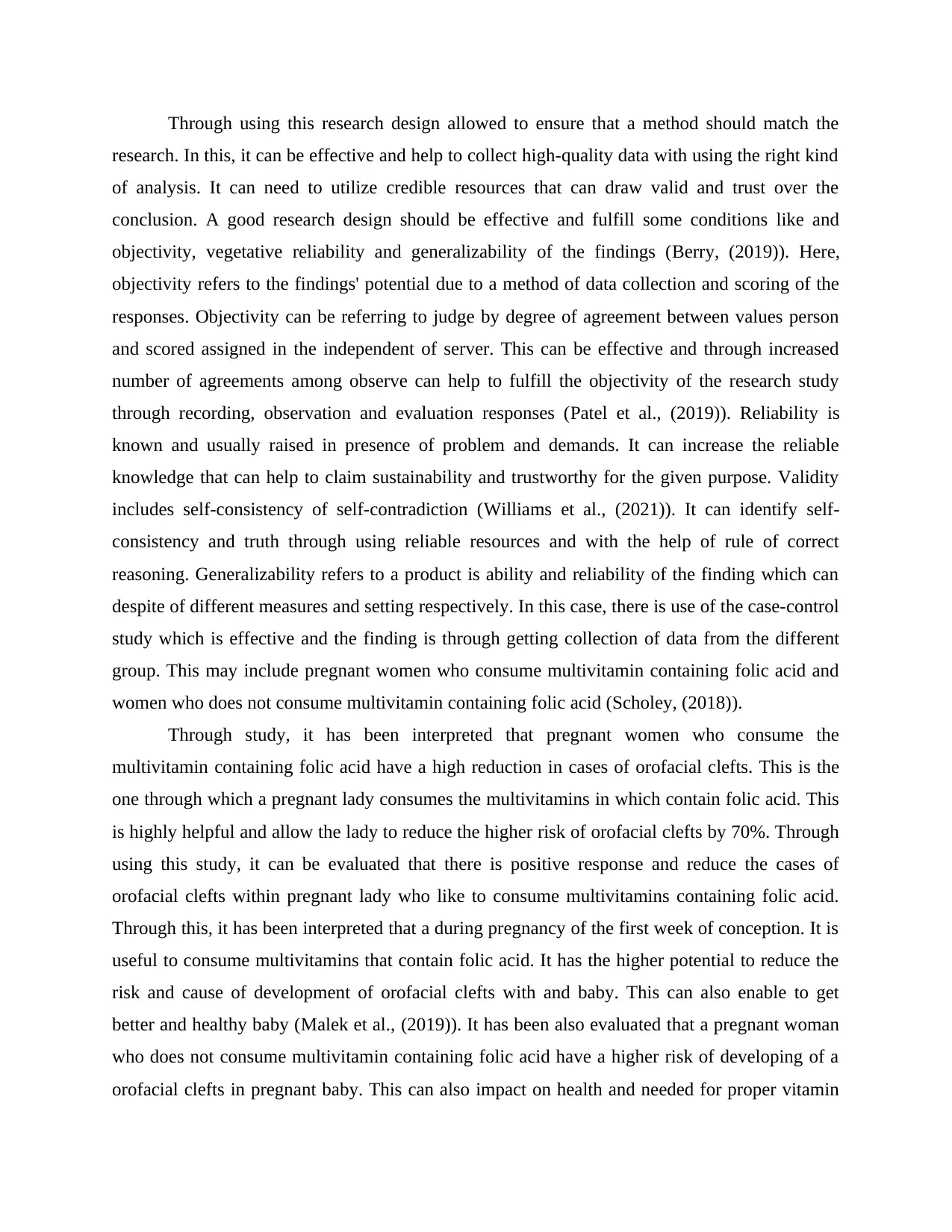
Through using this research design allowed to ensure that a method should match the
research. In this, it can be effective and help to collect high-quality data with using the right kind
of analysis. It can need to utilize credible resources that can draw valid and trust over the
conclusion. A good research design should be effective and fulfill some conditions like and
objectivity, vegetative reliability and generalizability of the findings (Berry, (2019)). Here,
objectivity refers to the findings' potential due to a method of data collection and scoring of the
responses. Objectivity can be referring to judge by degree of agreement between values person
and scored assigned in the independent of server. This can be effective and through increased
number of agreements among observe can help to fulfill the objectivity of the research study
through recording, observation and evaluation responses (Patel et al., (2019)). Reliability is
known and usually raised in presence of problem and demands. It can increase the reliable
knowledge that can help to claim sustainability and trustworthy for the given purpose. Validity
includes self-consistency of self-contradiction (Williams et al., (2021)). It can identify self-
consistency and truth through using reliable resources and with the help of rule of correct
reasoning. Generalizability refers to a product is ability and reliability of the finding which can
despite of different measures and setting respectively. In this case, there is use of the case-control
study which is effective and the finding is through getting collection of data from the different
group. This may include pregnant women who consume multivitamin containing folic acid and
women who does not consume multivitamin containing folic acid (Scholey, (2018)).
Through study, it has been interpreted that pregnant women who consume the
multivitamin containing folic acid have a high reduction in cases of orofacial clefts. This is the
one through which a pregnant lady consumes the multivitamins in which contain folic acid. This
is highly helpful and allow the lady to reduce the higher risk of orofacial clefts by 70%. Through
using this study, it can be evaluated that there is positive response and reduce the cases of
orofacial clefts within pregnant lady who like to consume multivitamins containing folic acid.
Through this, it has been interpreted that a during pregnancy of the first week of conception. It is
useful to consume multivitamins that contain folic acid. It has the higher potential to reduce the
risk and cause of development of orofacial clefts with and baby. This can also enable to get
better and healthy baby (Malek et al., (2019)). It has been also evaluated that a pregnant woman
who does not consume multivitamin containing folic acid have a higher risk of developing of a
orofacial clefts in pregnant baby. This can also impact on health and needed for proper vitamin
research. In this, it can be effective and help to collect high-quality data with using the right kind
of analysis. It can need to utilize credible resources that can draw valid and trust over the
conclusion. A good research design should be effective and fulfill some conditions like and
objectivity, vegetative reliability and generalizability of the findings (Berry, (2019)). Here,
objectivity refers to the findings' potential due to a method of data collection and scoring of the
responses. Objectivity can be referring to judge by degree of agreement between values person
and scored assigned in the independent of server. This can be effective and through increased
number of agreements among observe can help to fulfill the objectivity of the research study
through recording, observation and evaluation responses (Patel et al., (2019)). Reliability is
known and usually raised in presence of problem and demands. It can increase the reliable
knowledge that can help to claim sustainability and trustworthy for the given purpose. Validity
includes self-consistency of self-contradiction (Williams et al., (2021)). It can identify self-
consistency and truth through using reliable resources and with the help of rule of correct
reasoning. Generalizability refers to a product is ability and reliability of the finding which can
despite of different measures and setting respectively. In this case, there is use of the case-control
study which is effective and the finding is through getting collection of data from the different
group. This may include pregnant women who consume multivitamin containing folic acid and
women who does not consume multivitamin containing folic acid (Scholey, (2018)).
Through study, it has been interpreted that pregnant women who consume the
multivitamin containing folic acid have a high reduction in cases of orofacial clefts. This is the
one through which a pregnant lady consumes the multivitamins in which contain folic acid. This
is highly helpful and allow the lady to reduce the higher risk of orofacial clefts by 70%. Through
using this study, it can be evaluated that there is positive response and reduce the cases of
orofacial clefts within pregnant lady who like to consume multivitamins containing folic acid.
Through this, it has been interpreted that a during pregnancy of the first week of conception. It is
useful to consume multivitamins that contain folic acid. It has the higher potential to reduce the
risk and cause of development of orofacial clefts with and baby. This can also enable to get
better and healthy baby (Malek et al., (2019)). It has been also evaluated that a pregnant woman
who does not consume multivitamin containing folic acid have a higher risk of developing of a
orofacial clefts in pregnant baby. This can also impact on health and needed for proper vitamin
⊘ This is a preview!⊘
Do you want full access?
Subscribe today to unlock all pages.

Trusted by 1+ million students worldwide
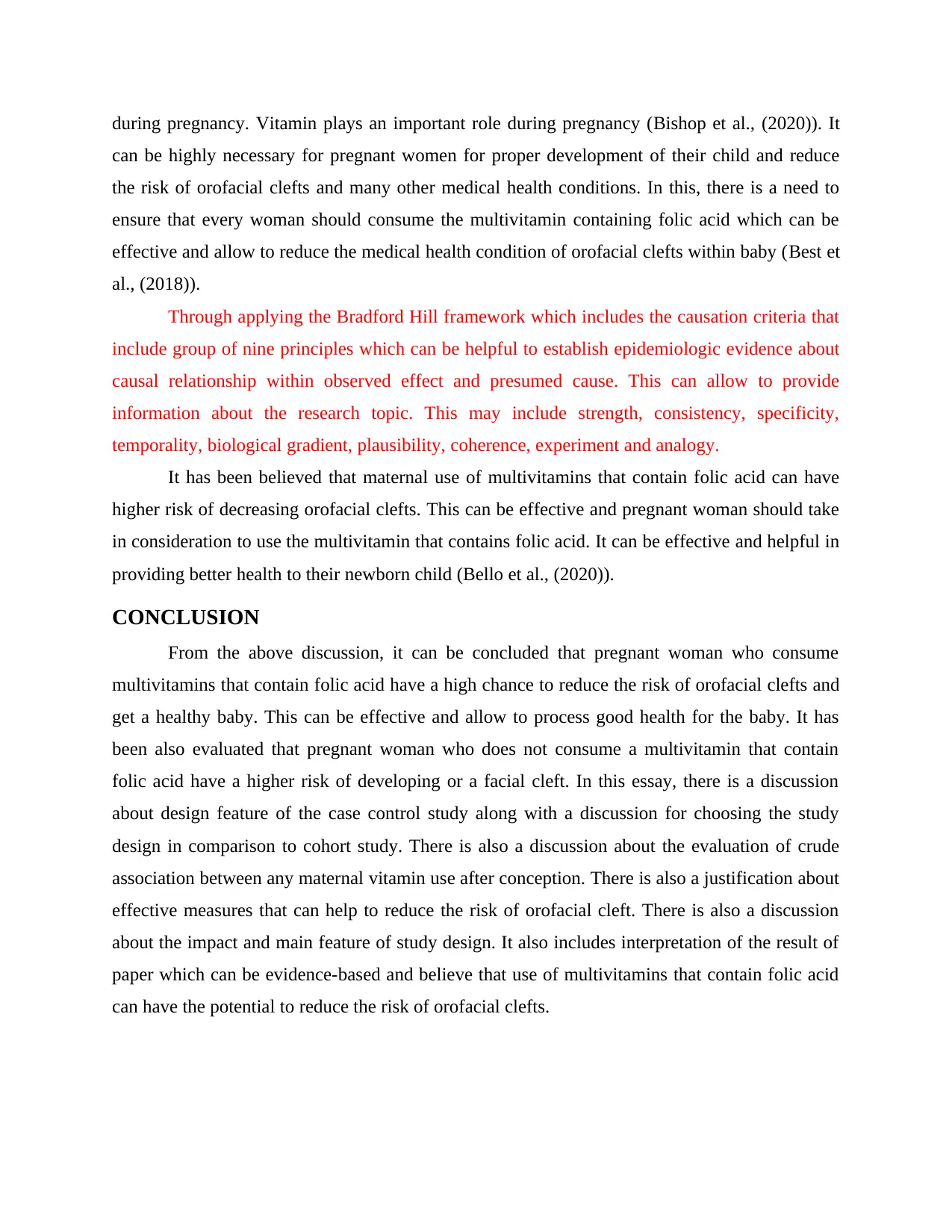
during pregnancy. Vitamin plays an important role during pregnancy (Bishop et al., (2020)). It
can be highly necessary for pregnant women for proper development of their child and reduce
the risk of orofacial clefts and many other medical health conditions. In this, there is a need to
ensure that every woman should consume the multivitamin containing folic acid which can be
effective and allow to reduce the medical health condition of orofacial clefts within baby (Best et
al., (2018)).
Through applying the Bradford Hill framework which includes the causation criteria that
include group of nine principles which can be helpful to establish epidemiologic evidence about
causal relationship within observed effect and presumed cause. This can allow to provide
information about the research topic. This may include strength, consistency, specificity,
temporality, biological gradient, plausibility, coherence, experiment and analogy.
It has been believed that maternal use of multivitamins that contain folic acid can have
higher risk of decreasing orofacial clefts. This can be effective and pregnant woman should take
in consideration to use the multivitamin that contains folic acid. It can be effective and helpful in
providing better health to their newborn child (Bello et al., (2020)).
CONCLUSION
From the above discussion, it can be concluded that pregnant woman who consume
multivitamins that contain folic acid have a high chance to reduce the risk of orofacial clefts and
get a healthy baby. This can be effective and allow to process good health for the baby. It has
been also evaluated that pregnant woman who does not consume a multivitamin that contain
folic acid have a higher risk of developing or a facial cleft. In this essay, there is a discussion
about design feature of the case control study along with a discussion for choosing the study
design in comparison to cohort study. There is also a discussion about the evaluation of crude
association between any maternal vitamin use after conception. There is also a justification about
effective measures that can help to reduce the risk of orofacial cleft. There is also a discussion
about the impact and main feature of study design. It also includes interpretation of the result of
paper which can be evidence-based and believe that use of multivitamins that contain folic acid
can have the potential to reduce the risk of orofacial clefts.
can be highly necessary for pregnant women for proper development of their child and reduce
the risk of orofacial clefts and many other medical health conditions. In this, there is a need to
ensure that every woman should consume the multivitamin containing folic acid which can be
effective and allow to reduce the medical health condition of orofacial clefts within baby (Best et
al., (2018)).
Through applying the Bradford Hill framework which includes the causation criteria that
include group of nine principles which can be helpful to establish epidemiologic evidence about
causal relationship within observed effect and presumed cause. This can allow to provide
information about the research topic. This may include strength, consistency, specificity,
temporality, biological gradient, plausibility, coherence, experiment and analogy.
It has been believed that maternal use of multivitamins that contain folic acid can have
higher risk of decreasing orofacial clefts. This can be effective and pregnant woman should take
in consideration to use the multivitamin that contains folic acid. It can be effective and helpful in
providing better health to their newborn child (Bello et al., (2020)).
CONCLUSION
From the above discussion, it can be concluded that pregnant woman who consume
multivitamins that contain folic acid have a high chance to reduce the risk of orofacial clefts and
get a healthy baby. This can be effective and allow to process good health for the baby. It has
been also evaluated that pregnant woman who does not consume a multivitamin that contain
folic acid have a higher risk of developing or a facial cleft. In this essay, there is a discussion
about design feature of the case control study along with a discussion for choosing the study
design in comparison to cohort study. There is also a discussion about the evaluation of crude
association between any maternal vitamin use after conception. There is also a justification about
effective measures that can help to reduce the risk of orofacial cleft. There is also a discussion
about the impact and main feature of study design. It also includes interpretation of the result of
paper which can be evidence-based and believe that use of multivitamins that contain folic acid
can have the potential to reduce the risk of orofacial clefts.
Paraphrase This Document
Need a fresh take? Get an instant paraphrase of this document with our AI Paraphraser

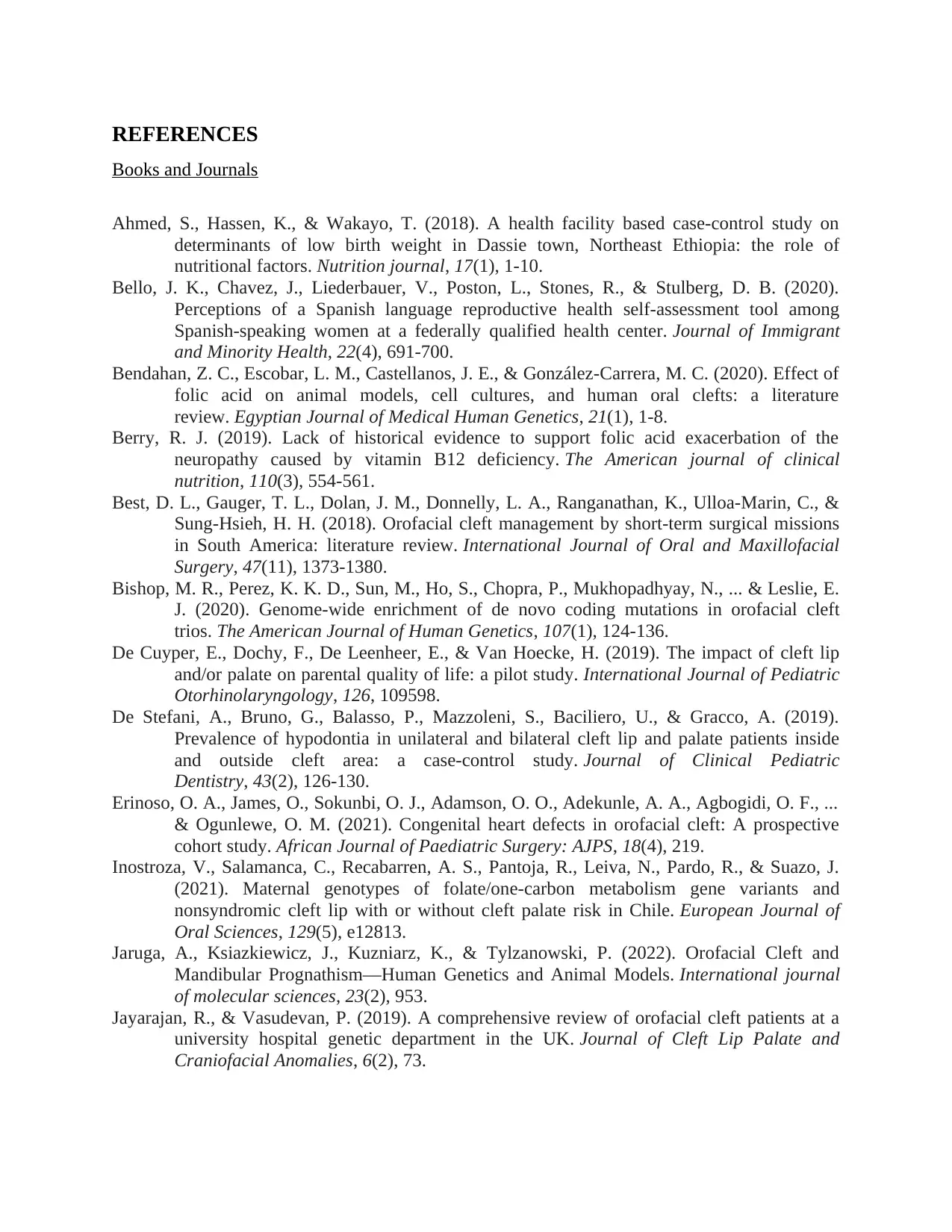
REFERENCES
Books and Journals
Ahmed, S., Hassen, K., & Wakayo, T. (2018). A health facility based case-control study on
determinants of low birth weight in Dassie town, Northeast Ethiopia: the role of
nutritional factors. Nutrition journal, 17(1), 1-10.
Bello, J. K., Chavez, J., Liederbauer, V., Poston, L., Stones, R., & Stulberg, D. B. (2020).
Perceptions of a Spanish language reproductive health self-assessment tool among
Spanish-speaking women at a federally qualified health center. Journal of Immigrant
and Minority Health, 22(4), 691-700.
Bendahan, Z. C., Escobar, L. M., Castellanos, J. E., & González-Carrera, M. C. (2020). Effect of
folic acid on animal models, cell cultures, and human oral clefts: a literature
review. Egyptian Journal of Medical Human Genetics, 21(1), 1-8.
Berry, R. J. (2019). Lack of historical evidence to support folic acid exacerbation of the
neuropathy caused by vitamin B12 deficiency. The American journal of clinical
nutrition, 110(3), 554-561.
Best, D. L., Gauger, T. L., Dolan, J. M., Donnelly, L. A., Ranganathan, K., Ulloa-Marin, C., &
Sung-Hsieh, H. H. (2018). Orofacial cleft management by short-term surgical missions
in South America: literature review. International Journal of Oral and Maxillofacial
Surgery, 47(11), 1373-1380.
Bishop, M. R., Perez, K. K. D., Sun, M., Ho, S., Chopra, P., Mukhopadhyay, N., ... & Leslie, E.
J. (2020). Genome-wide enrichment of de novo coding mutations in orofacial cleft
trios. The American Journal of Human Genetics, 107(1), 124-136.
De Cuyper, E., Dochy, F., De Leenheer, E., & Van Hoecke, H. (2019). The impact of cleft lip
and/or palate on parental quality of life: a pilot study. International Journal of Pediatric
Otorhinolaryngology, 126, 109598.
De Stefani, A., Bruno, G., Balasso, P., Mazzoleni, S., Baciliero, U., & Gracco, A. (2019).
Prevalence of hypodontia in unilateral and bilateral cleft lip and palate patients inside
and outside cleft area: a case-control study. Journal of Clinical Pediatric
Dentistry, 43(2), 126-130.
Erinoso, O. A., James, O., Sokunbi, O. J., Adamson, O. O., Adekunle, A. A., Agbogidi, O. F., ...
& Ogunlewe, O. M. (2021). Congenital heart defects in orofacial cleft: A prospective
cohort study. African Journal of Paediatric Surgery: AJPS, 18(4), 219.
Inostroza, V., Salamanca, C., Recabarren, A. S., Pantoja, R., Leiva, N., Pardo, R., & Suazo, J.
(2021). Maternal genotypes of folate/one‐carbon metabolism gene variants and
nonsyndromic cleft lip with or without cleft palate risk in Chile. European Journal of
Oral Sciences, 129(5), e12813.
Jaruga, A., Ksiazkiewicz, J., Kuzniarz, K., & Tylzanowski, P. (2022). Orofacial Cleft and
Mandibular Prognathism—Human Genetics and Animal Models. International journal
of molecular sciences, 23(2), 953.
Jayarajan, R., & Vasudevan, P. (2019). A comprehensive review of orofacial cleft patients at a
university hospital genetic department in the UK. Journal of Cleft Lip Palate and
Craniofacial Anomalies, 6(2), 73.
Books and Journals
Ahmed, S., Hassen, K., & Wakayo, T. (2018). A health facility based case-control study on
determinants of low birth weight in Dassie town, Northeast Ethiopia: the role of
nutritional factors. Nutrition journal, 17(1), 1-10.
Bello, J. K., Chavez, J., Liederbauer, V., Poston, L., Stones, R., & Stulberg, D. B. (2020).
Perceptions of a Spanish language reproductive health self-assessment tool among
Spanish-speaking women at a federally qualified health center. Journal of Immigrant
and Minority Health, 22(4), 691-700.
Bendahan, Z. C., Escobar, L. M., Castellanos, J. E., & González-Carrera, M. C. (2020). Effect of
folic acid on animal models, cell cultures, and human oral clefts: a literature
review. Egyptian Journal of Medical Human Genetics, 21(1), 1-8.
Berry, R. J. (2019). Lack of historical evidence to support folic acid exacerbation of the
neuropathy caused by vitamin B12 deficiency. The American journal of clinical
nutrition, 110(3), 554-561.
Best, D. L., Gauger, T. L., Dolan, J. M., Donnelly, L. A., Ranganathan, K., Ulloa-Marin, C., &
Sung-Hsieh, H. H. (2018). Orofacial cleft management by short-term surgical missions
in South America: literature review. International Journal of Oral and Maxillofacial
Surgery, 47(11), 1373-1380.
Bishop, M. R., Perez, K. K. D., Sun, M., Ho, S., Chopra, P., Mukhopadhyay, N., ... & Leslie, E.
J. (2020). Genome-wide enrichment of de novo coding mutations in orofacial cleft
trios. The American Journal of Human Genetics, 107(1), 124-136.
De Cuyper, E., Dochy, F., De Leenheer, E., & Van Hoecke, H. (2019). The impact of cleft lip
and/or palate on parental quality of life: a pilot study. International Journal of Pediatric
Otorhinolaryngology, 126, 109598.
De Stefani, A., Bruno, G., Balasso, P., Mazzoleni, S., Baciliero, U., & Gracco, A. (2019).
Prevalence of hypodontia in unilateral and bilateral cleft lip and palate patients inside
and outside cleft area: a case-control study. Journal of Clinical Pediatric
Dentistry, 43(2), 126-130.
Erinoso, O. A., James, O., Sokunbi, O. J., Adamson, O. O., Adekunle, A. A., Agbogidi, O. F., ...
& Ogunlewe, O. M. (2021). Congenital heart defects in orofacial cleft: A prospective
cohort study. African Journal of Paediatric Surgery: AJPS, 18(4), 219.
Inostroza, V., Salamanca, C., Recabarren, A. S., Pantoja, R., Leiva, N., Pardo, R., & Suazo, J.
(2021). Maternal genotypes of folate/one‐carbon metabolism gene variants and
nonsyndromic cleft lip with or without cleft palate risk in Chile. European Journal of
Oral Sciences, 129(5), e12813.
Jaruga, A., Ksiazkiewicz, J., Kuzniarz, K., & Tylzanowski, P. (2022). Orofacial Cleft and
Mandibular Prognathism—Human Genetics and Animal Models. International journal
of molecular sciences, 23(2), 953.
Jayarajan, R., & Vasudevan, P. (2019). A comprehensive review of orofacial cleft patients at a
university hospital genetic department in the UK. Journal of Cleft Lip Palate and
Craniofacial Anomalies, 6(2), 73.
⊘ This is a preview!⊘
Do you want full access?
Subscribe today to unlock all pages.

Trusted by 1+ million students worldwide
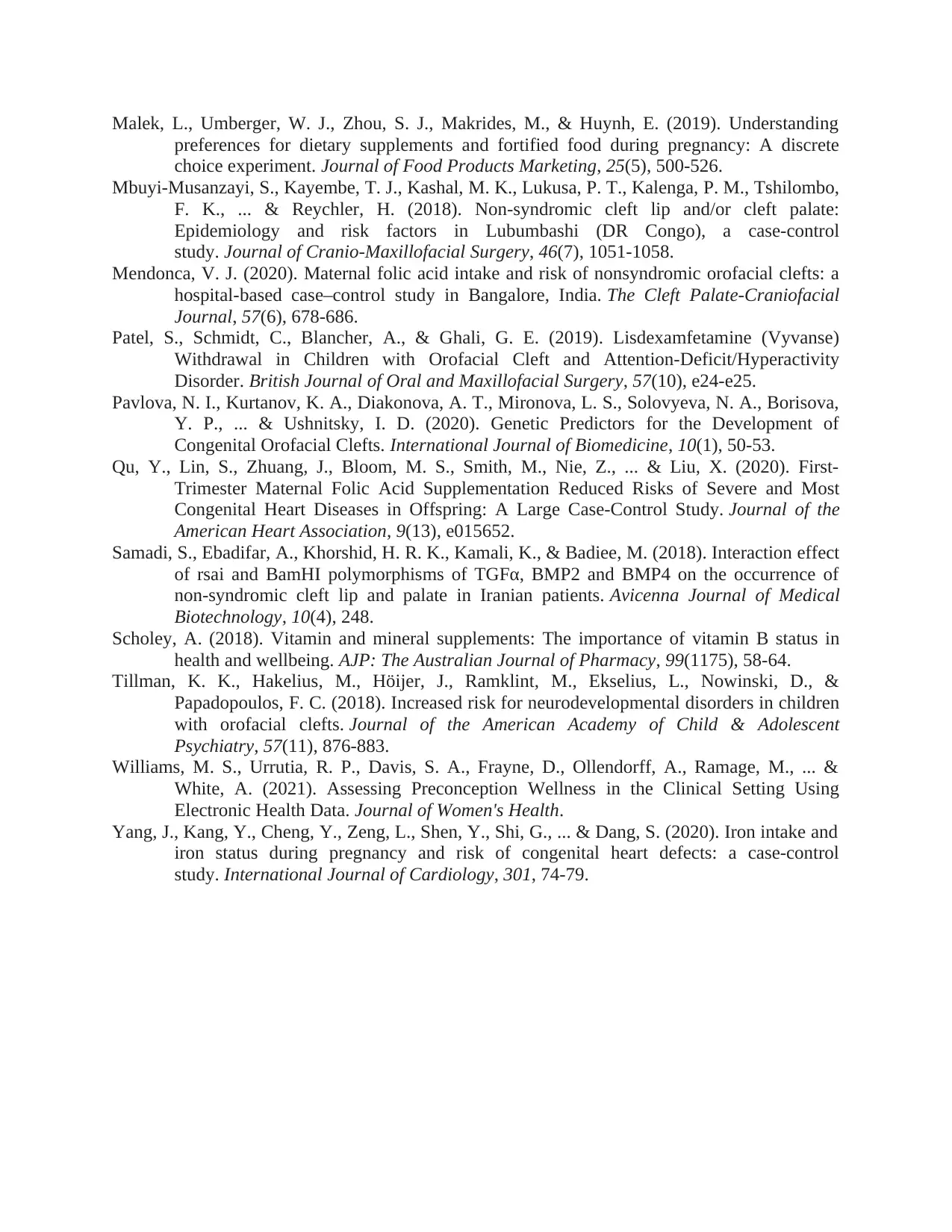
Malek, L., Umberger, W. J., Zhou, S. J., Makrides, M., & Huynh, E. (2019). Understanding
preferences for dietary supplements and fortified food during pregnancy: A discrete
choice experiment. Journal of Food Products Marketing, 25(5), 500-526.
Mbuyi-Musanzayi, S., Kayembe, T. J., Kashal, M. K., Lukusa, P. T., Kalenga, P. M., Tshilombo,
F. K., ... & Reychler, H. (2018). Non-syndromic cleft lip and/or cleft palate:
Epidemiology and risk factors in Lubumbashi (DR Congo), a case-control
study. Journal of Cranio-Maxillofacial Surgery, 46(7), 1051-1058.
Mendonca, V. J. (2020). Maternal folic acid intake and risk of nonsyndromic orofacial clefts: a
hospital-based case–control study in Bangalore, India. The Cleft Palate-Craniofacial
Journal, 57(6), 678-686.
Patel, S., Schmidt, C., Blancher, A., & Ghali, G. E. (2019). Lisdexamfetamine (Vyvanse)
Withdrawal in Children with Orofacial Cleft and Attention-Deficit/Hyperactivity
Disorder. British Journal of Oral and Maxillofacial Surgery, 57(10), e24-e25.
Pavlova, N. I., Kurtanov, K. A., Diakonova, A. T., Mironova, L. S., Solovyeva, N. A., Borisova,
Y. P., ... & Ushnitsky, I. D. (2020). Genetic Predictors for the Development of
Congenital Orofacial Clefts. International Journal of Biomedicine, 10(1), 50-53.
Qu, Y., Lin, S., Zhuang, J., Bloom, M. S., Smith, M., Nie, Z., ... & Liu, X. (2020). First‐
Trimester Maternal Folic Acid Supplementation Reduced Risks of Severe and Most
Congenital Heart Diseases in Offspring: A Large Case‐Control Study. Journal of the
American Heart Association, 9(13), e015652.
Samadi, S., Ebadifar, A., Khorshid, H. R. K., Kamali, K., & Badiee, M. (2018). Interaction effect
of rsai and BamHI polymorphisms of TGFα, BMP2 and BMP4 on the occurrence of
non-syndromic cleft lip and palate in Iranian patients. Avicenna Journal of Medical
Biotechnology, 10(4), 248.
Scholey, A. (2018). Vitamin and mineral supplements: The importance of vitamin B status in
health and wellbeing. AJP: The Australian Journal of Pharmacy, 99(1175), 58-64.
Tillman, K. K., Hakelius, M., Höijer, J., Ramklint, M., Ekselius, L., Nowinski, D., &
Papadopoulos, F. C. (2018). Increased risk for neurodevelopmental disorders in children
with orofacial clefts. Journal of the American Academy of Child & Adolescent
Psychiatry, 57(11), 876-883.
Williams, M. S., Urrutia, R. P., Davis, S. A., Frayne, D., Ollendorff, A., Ramage, M., ... &
White, A. (2021). Assessing Preconception Wellness in the Clinical Setting Using
Electronic Health Data. Journal of Women's Health.
Yang, J., Kang, Y., Cheng, Y., Zeng, L., Shen, Y., Shi, G., ... & Dang, S. (2020). Iron intake and
iron status during pregnancy and risk of congenital heart defects: a case-control
study. International Journal of Cardiology, 301, 74-79.
preferences for dietary supplements and fortified food during pregnancy: A discrete
choice experiment. Journal of Food Products Marketing, 25(5), 500-526.
Mbuyi-Musanzayi, S., Kayembe, T. J., Kashal, M. K., Lukusa, P. T., Kalenga, P. M., Tshilombo,
F. K., ... & Reychler, H. (2018). Non-syndromic cleft lip and/or cleft palate:
Epidemiology and risk factors in Lubumbashi (DR Congo), a case-control
study. Journal of Cranio-Maxillofacial Surgery, 46(7), 1051-1058.
Mendonca, V. J. (2020). Maternal folic acid intake and risk of nonsyndromic orofacial clefts: a
hospital-based case–control study in Bangalore, India. The Cleft Palate-Craniofacial
Journal, 57(6), 678-686.
Patel, S., Schmidt, C., Blancher, A., & Ghali, G. E. (2019). Lisdexamfetamine (Vyvanse)
Withdrawal in Children with Orofacial Cleft and Attention-Deficit/Hyperactivity
Disorder. British Journal of Oral and Maxillofacial Surgery, 57(10), e24-e25.
Pavlova, N. I., Kurtanov, K. A., Diakonova, A. T., Mironova, L. S., Solovyeva, N. A., Borisova,
Y. P., ... & Ushnitsky, I. D. (2020). Genetic Predictors for the Development of
Congenital Orofacial Clefts. International Journal of Biomedicine, 10(1), 50-53.
Qu, Y., Lin, S., Zhuang, J., Bloom, M. S., Smith, M., Nie, Z., ... & Liu, X. (2020). First‐
Trimester Maternal Folic Acid Supplementation Reduced Risks of Severe and Most
Congenital Heart Diseases in Offspring: A Large Case‐Control Study. Journal of the
American Heart Association, 9(13), e015652.
Samadi, S., Ebadifar, A., Khorshid, H. R. K., Kamali, K., & Badiee, M. (2018). Interaction effect
of rsai and BamHI polymorphisms of TGFα, BMP2 and BMP4 on the occurrence of
non-syndromic cleft lip and palate in Iranian patients. Avicenna Journal of Medical
Biotechnology, 10(4), 248.
Scholey, A. (2018). Vitamin and mineral supplements: The importance of vitamin B status in
health and wellbeing. AJP: The Australian Journal of Pharmacy, 99(1175), 58-64.
Tillman, K. K., Hakelius, M., Höijer, J., Ramklint, M., Ekselius, L., Nowinski, D., &
Papadopoulos, F. C. (2018). Increased risk for neurodevelopmental disorders in children
with orofacial clefts. Journal of the American Academy of Child & Adolescent
Psychiatry, 57(11), 876-883.
Williams, M. S., Urrutia, R. P., Davis, S. A., Frayne, D., Ollendorff, A., Ramage, M., ... &
White, A. (2021). Assessing Preconception Wellness in the Clinical Setting Using
Electronic Health Data. Journal of Women's Health.
Yang, J., Kang, Y., Cheng, Y., Zeng, L., Shen, Y., Shi, G., ... & Dang, S. (2020). Iron intake and
iron status during pregnancy and risk of congenital heart defects: a case-control
study. International Journal of Cardiology, 301, 74-79.
1 out of 10
Related Documents
Your All-in-One AI-Powered Toolkit for Academic Success.
+13062052269
info@desklib.com
Available 24*7 on WhatsApp / Email
![[object Object]](/_next/static/media/star-bottom.7253800d.svg)
Unlock your academic potential
Copyright © 2020–2025 A2Z Services. All Rights Reserved. Developed and managed by ZUCOL.





